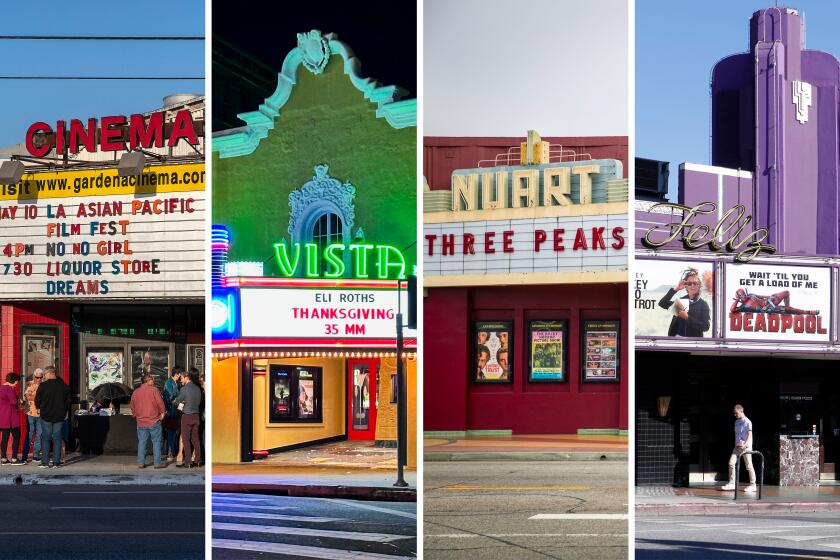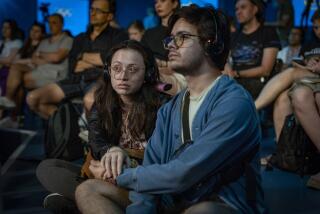Review: Defending one’s homeland and the right to make art become common cause in ‘Porcelain War’

- Share via
Guns, paintbrushes and cameras are tools of national defense for the Ukrainian artists at the center of “Porcelain War,” a sublime and stirring documentary from American filmmaker Brendan Bellomo and Ukrainian ceramicist Slava Leontyev about living, fighting and creating under siege.
The Sundance-honored film is more timely now, not only because of how pivotal this power-shifting moment is for Ukraine but also because we need reminders that culture can be a steady heartbeat of resistance against the world’s darkest forces. The setting could not be starker in its extremes. Only miles from the devastation wrought by Russia’s bombing of Kharkiv, Slava and his wife, Anya Stasenko, work in porcelain, surrounded by rapturous nature. He carefully shapes and polishes the figurines — a snail, an owl, a tiny dragon — that she then hand-colors with Swiss-watch precision, adorning the molded forms with miniature scenes of depth and texture.
But Slava is also, out of pure obligation to the reality of his country being invaded, part of a dedicated special forces unit of Ukrainian civilians — from doctors to farmers — who’ve had to learn the art of warfare: operating guns and drones. That battle-contoured contrast of beauty and survival is what spurred the California-based Bellomo, a friend of the artists, to smuggle in cameras so that Slava, with the help of a family friend, could film their defiantly creative lives under threat of obliteration. To leave, says Anya, would be like “cutting off your own shadow.” But staying can’t help but invite thoughts of the wolf at the door.
We’ve mapped out 27 of the best movie theaters in L.A., from the TCL Chinese and the New Beverly to the Alamo Drafthouse and which AMC reigns in Burbank.
The result is a fascinating portrait about holding the line, in which the territory is as much a collective state of mind as an encroached-upon sovereignty. There’s a reason for the text at the beginning letting us know that nearly everything we see in “Porcelain War” was filmed by its subjects, because knowing who’s behind the camera allows us to absorb the images as a willful counterbalance to despair: light bathing a meadow teeming with life, how couples banter with a few drinks in them, the pair’s adorable canine companion, Frodo. The new-toy innocence of these first-time cinematographers is, in some ways, an ideal symbol for the spiritual reinforcement they get from prioritizing their art.
Even tableaux of destruction compel the eye, less war as spectacle than some horrific inverse of the creative process. So when we shift to scenes of Slava’s tight-knit unit securing areas and dropping explosives from (what else?) painted drones, we feel like we’re among a community of more than mere combatants. The concept of the “citizen soldier,” a mantle accepted heavily but with focus and spirit, has never felt more resonant than as depicted by the co-directors of “Porcelain War.”
There are aesthetic touches too that in other films might have seemed too precious, but in “Porcelain War” feel just right, as when Anya’s detailed artwork on their figurines’ porcelain surface is made to move with subtly rendered animation, enriching the idea that these tiny sculptures aren’t just canvases — they’re also portals for experiences that are never still. That sacred meeting place of myth and life is also fully realized by the film’s pulsing, powerful score, a knockout sampling of Ukrainian neo-folk outfit DakhaBrakha’s liberating music, which you can feel traveling from the earth and into your bones like a gathering strength.
“Porcelain War” understands that great art can do that — act as both a bulwark and beacon — and that soulful artists like Slava and Anya know it’s worth fighting to preserve.
'Porcelain War'
In Ukrainian with English subtitles
Rated: R, for language
Running time: 1 hour, 27 minutes
Playing: Opens Nov. 27, Laemmle Monica Film Center, West Los Angeles
More to Read
Only good movies
Get the Indie Focus newsletter, Mark Olsen's weekly guide to the world of cinema.
You may occasionally receive promotional content from the Los Angeles Times.











